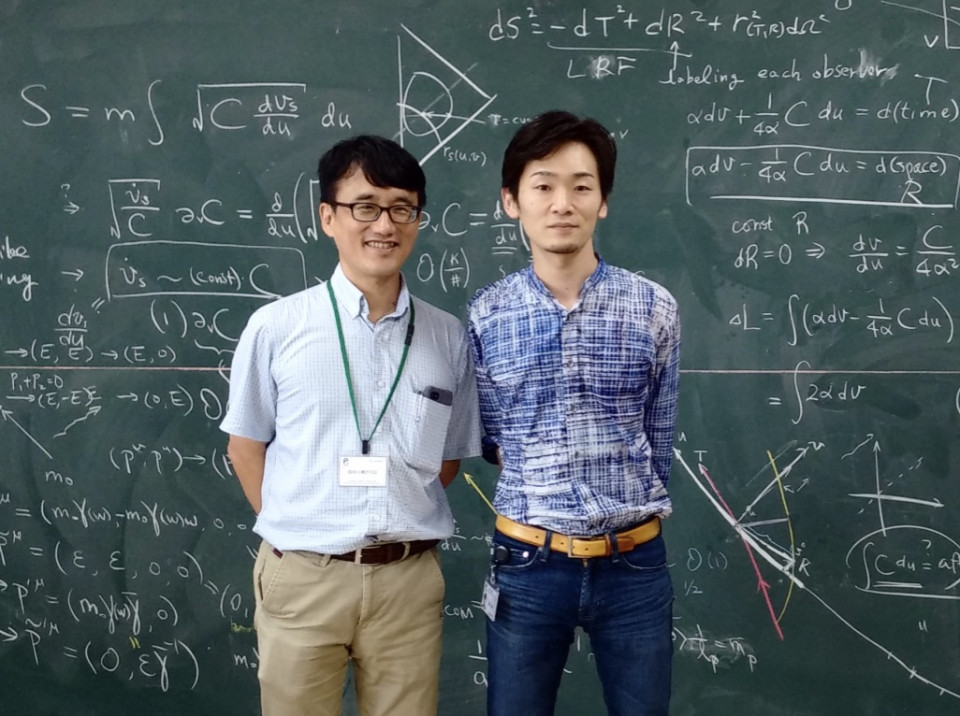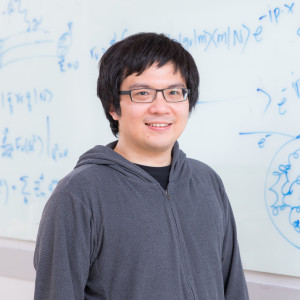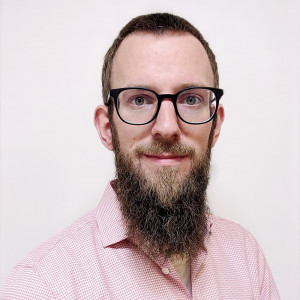Volume 86
Back to Newsletter List
Featured Paper of the Week
Distance between collapsing matter and trapping horizon in evaporating black holes
2020-01-24
How deep can an apple fall into the horizon of a black hole? Of course, in the case of a classic black hole, the apple reaches the center. However, the real world is described by quantum theory, and black holes evaporate by Hawking radiation. This changes the fate of the apple. Negative energy due to vacuum quantum fluctuations is generated near black holes, which enters the black holes and reduces their energy. If there is a horizon, the negative energy will make the horizon smaller. Then, the horizon becomes timelike (while it is null in the classical case). In this paper, we solved approximately the Einstein equation in the vicinity of the horizon and examined the physical (proper) distance between the falling apple and the horizon. It turned out that the distance is a few of the Planck length (due to the exponentially delayed time inside the horizon). This means that essentially no apples fall into the black hole. This result suggest that we should reconsider whether the black hole really has a horizon.
Reference:
Pei-Ming Ho, Yoshinori Matsuo, Yuki Yokokura
"Distance between collapsing matter and trapping horizon in evaporating black holes"
Phys. Rev. D 104, 064005 (2021)
doi: 10.1103/PhysRevD.104.064005
arXiv: 1912.12863
Upcoming Events
Seminar
ABBL-iTHEMS Joint Astro Seminar
ABBL/iTHEMS seminar - talk on neutron stars
January 24 (Fri) 14:00 - 15:00, 2020
Hajime Sotani (Research Scientist, RIKEN Interdisciplinary Theoretical and Mathematical Sciences Program (iTHEMS) / Research Scientist, Astrophysical Big Bang Laboratory, RIKEN Cluster for Pioneering Research (CPR))
Venue: Seminar Room #132, 1F Main Research Building, RIKEN
Event Official Language: English
Workshop
CREST Tutorial Workshop
January 26 (Sun) - 28 (Tue) 2020
This workshop is co-organized by CREST Research Project "[Topology] Creation of Core Technology based on the Topological Materials Science for Innovative Devices" and RIKEN iTHEMS.
Venue: Graduate School of Mathematical Sciences, The University of Tokyo
Event Official Language: Japanese
Workshop
Workshop on quantum information science
January 29 (Wed) 10:00 - 18:00, 2020
Venue: Suzuki Umetaro Hall, 1F Bioscience Building, RIKEN
Event Official Language: Japanese
Seminar
ABBL-iTHEMS Joint Astro Seminar
ABBL/iTHEMS seminar - talk on ultra-high energy cosmic rays
January 31 (Fri) 14:00 - 15:00, 2020
Eiji Kido (Astrophysical Big Bang Laboratory, RIKEN Cluster for Pioneering Research (CPR))
Venue: Seminar Room #132, 1F Main Research Building, RIKEN
Event Official Language: English
Seminar
iTHEMS Math Seminar
Index of the Wilson-Dirac operator revisited: a discrete version of Dirac operator on a finite lattice
February 25 (Tue) 16:00 - 18:10, 2020
Mikio Furuta (Professor, The University of Tokyo)
The Wilson-Dirac operator is a discrete version of Dirac operator defined on regular lattices. When the discrete version is a fine approximation of the Dirac operator on a Z/2-graded Clifford module on a torus, it is known that (1) an integer-valued index is defined for the Wilson-Dirac operator, and (2) the index is equal to the Atiyah-Singer index of the Dirac operator on the torus.
These have been well established up to around 2000. The strategy of all the previous works is to make use of the discrete version of the heat kernel for Neuberger's overlap Dirac operator. Therefore the strategy cannot be generalized to mod 2 index nor family version of index.
In this talk I would like to explain a new approach to the index of Wilson-Dirac operator which can be immediately generalized to these various cases.
Joint work with H. Fukaya, S. Matsuo, T. Onogi, S. Yamaguchi and M. Yamashita.
Venue: Seminar Room #160, 1F Main Research Building, RIKEN
Event Official Language: English
Upcoming Visitor
January 27 (Mon) - February 3 (Mon) 2020 Jason ChangResearch Scientist, RIKEN Interdisciplinary Theoretical and Mathematical Sciences Program (iTHEMS) / LBNL/UCB, USA Research fields: Particle and Nuclear Physics Visiting Place: #233, 2F, Main Research Building |
Person of the Week
Self-introduction: Martin Skrodzki
2020-01-23
My name is Martin Skrodzki and I was born in Germany. I studied computer science and mathematics from 2008 to 2011 at TU Dortmund University in Germany where I obtained two Bachelor's degrees. Afterwards, I spend two terms on a Fulbright travel grant at the Texas A&M International University in Laredo, Texas, USA continuing with graduate studies in mathematics. I finishes these with a Master's degree at Freie Universität Berlin, Germany in 2014. My focus in the coursework and in my Master's thesis was on discrete geometry and discrete mathematics.
In early 2015, I started work on my PhD with Prof. Polthier at Freie Universität Berlin in the group "Mathematical Geometry Processing". My thesis, titled "Neighborhood Data Structures, Manifold Properties, and Processing of Point Set Surfaces" covers three topics all centered in the context of point set processing. Please find the thesis via the link shown below. I graduated with the title of "Dr. rer. nat" (doctor of the natural sciences) in July 2019. Immediately after my graduation, I started a first postdoc at the Institute of Computational and Experimental Research in Mathematics (ICERM), Brown University, Providence, RI, USA. The position was part of the topical semester program "Illustrating Mathematics" which was concerned about finding new, exciting visualizations of mathematical structures and objects, see the link shown below for some of the results obtained.
My research interests are set between computer science and mathematics. I am currently very interested in visualization of high-dimensional data via dimension-reduction methods. Memberships in the Society of Applied and Industrial Mathematics (SIAM), the Solid Modeling Association (SMA), and Eurographics (EG) form my professional network. Finally, I am also an associate editor of the Journal of Mathematics and the Arts (JMA).
If you would like to cancel your subscription or change your email address,
please let us know via our contact form.
Copyright © iTHEMS, RIKEN. All rights reserved.





